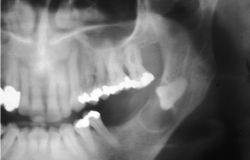By Carlotta Giuliano and Francesco Lerda
DESCRIPTION
The Dentigerous (Follicular) Cyst, the most common of the developmental of odontogenic cysts, develops by the accumulation of fluid within the follicular space of an unerupted tooth after its crown has fully formed.

HISTOLOGY
The epithelial covering of the cyst is a thin regular layer made of few cell layers; it is defined as a pluristratified non keratinized epithelium.
The metaplasia of the mucous membrane occurs frequently and increases as patient gets older. The cyst epithelium is covered by a capsule made of fibrous connective tissue that is usually relatively uninflamed except close to the junctional epithelium where a chronic inflammatory cell infiltrate may occur. Inside the cyst It can be found a protein fluid.

EPIDEMIOLOGY:
-10-15% of maxillary odontogenic cysts
-Wide range of age, especially occurs among adolescents and over 50s
-No difference between males and females
-No difference between maxilla and mandible
-Dentigerous cyst may occur more often in unerupted teeth
- The teeth most commonly affected are third molars and maxillary cuspids. No tooth is immune, but decidious teeth are scarcely ever affected.
SYMPTOMS
Small cysts are without symptoms but large ones expand the affected jaw and may cause pain and less often paresthesia .
DIAGNOSIS
Based on rx evidence Dentigerous cysts appears as a well-circumscribed,usually unilocular pericoronal radiolucency; they often are in contact with the crown of an included tooth which can be dislocated by the growth of the cyst itself.


PATHOGENESIS
Follicular cysts develop from follicular tissue, but the out breaking factors are nowadays unknown. The content of dentigerous cyst is ipertonic than plasma is, this is due to the presence of polycystin 1 and 2 wich increase the endocellular level of calcium. The Cyst, besides, owns factors that cause bone resorbtion like PGE2 and PGF2 and IL-1.
THERAPY
The therapy is a SURGICAL excision.
-Fauchard’s extraction technique
- Partsch I and II
-For the odontogenic maxillary cyst can be required a transnasal endoscopic surgery
COMPLICATIONS
Dentigerous cysts develop from follicular epithelium, and follicular epithelium has greater potential for growth, differentiation, and degeneration than the epithelium from which radicular cysts arise. Occasionally, other more ominous lesions arise within the walls of the dentigerous cyst, including mucoepidermoid carcinoma arising from mucous cells within the cyst walls, ameloblastoma and squamous cell carcinoma. This kind of cysts also can become quite large and can place the patient at risk for pathologic jaw fracture.